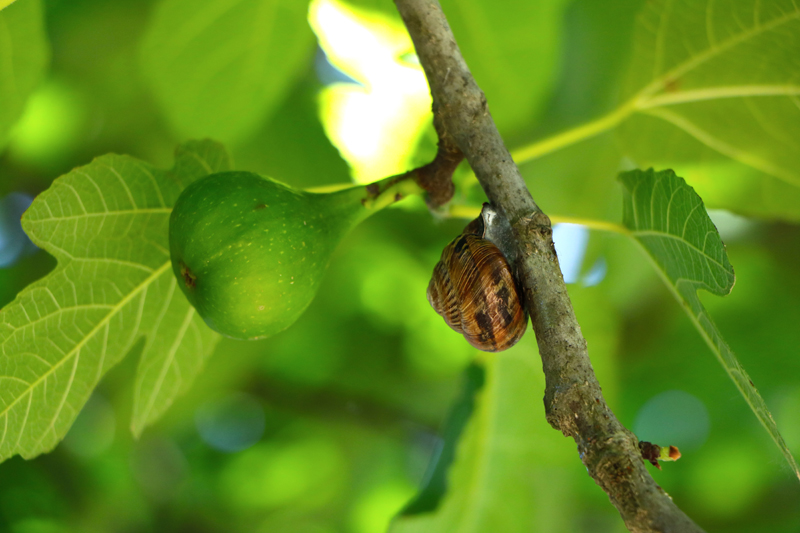
Even though it’s always been said that figs are a fruit, technically they are sicones, a fake fruit derived from different flowers covered in a concave and meaty receptacle; to put it simply, they are a small group of inverted flowers that grow inside a seath. Each seath contains hundreds of flowers, and every flower produces a small seed, which is the real fig tree fruit. Each fig has hundreds of achenes, which are a bit crunchy. This means that every time you eat a fig you’re actually eating several fruits at once. The surrounding meat of the achene (the softest and sweetest part that we enjoy the most) is only an accessory for these seeds, although for us and probably for you, it’s the main part of it :)
Directly from Extremadura
Figs grow in warm and dry environments like the mediterranean. Our dried figs, El Pajarero, come from Extremadura, which is the main Spanish autonomous community in extension and production of figs, since it’s the biggest region to grow fig trees in Spain. The unique characteristics of its climate and land gives them a special flavor, different from the pumpkin variety, a fig that has an exceptional melosity, superior to the other varieties which are bigger, but not as sweet.
How to consume them?
Fresh figs, depending on the variety, are only available from summer to the beginning of autumn, so they have a very short life. Before their consumption, you must note that figs don’t mature after being harvested, therefore you want to avoid ones that are not yet soft. Another thing to consider is that fresh figs are delicate and don’t last long. Make sure to keep them in the refrigerator and eat them a week after buying them. If you'd rather leave them outside to eat them at room temperature, you can keep them, at best, for a couple of days.
Because of all that has been stated previously, even though fresh figs are delicious, so you can keep enjoying their flavor and all its properties, dried figs are a very viable option, since you can consume them all year long either raw or in sweet or savory dishes.
The magic of dried figs
There’s something magical about eating a fig. You only need a bite to unleash its flavor and texture. Figs also are deeply rooted in human history. After all, how many other types of food have been mentioned in the Bible, eaten by Greek olympians and mentioned in antique mythology?
Yes, there is something magical inside figs. There’s a reason we have been eating them since the Neolithic: they’re easy to eat, delicious and of course, very nutritious.
Next time you find dried figs in your local grocery store, buy more than one box. Due to their versatility and endless possibilities, you’ll amaze yourself at how fast you’ll eat them!

If you're looking for a recipe of Oporto chicken with dried figs, you may find many recipes, especially in books (or blogs) relating to French cuisine. Dried figs, due to their versatility, are very popular in European countries, that’s why people use them often.
Still, we have prepared this recipe to make it as easy as possible step by step. It’s likely that this will be the easiest chicken Oporto with dried figs recipe you’ll find on the internet.
Now without further ado, let’s reveal our special recipe. We hope you'll be surprised by this amazing combination of flavors. It’s pretty easy to make. Let 's go!
Ingredients for four servings
- 4 hind quarters of free-range chicken
- 200 grams of dried figs El Pajarero
- 200 ml of water or broth
- 200 ml Oporto wine
- 50 ml apple vinegar
- Rosemary, salt and black pepper
- 1 tablespoon of olive oil
- 300g of fine peas for garnish
Preparation
Marinate the figs in the port and vinegar at least one hour in advance.
Once marinated, drain the figs and put them apart. Keep the juice from the marinade.
Meanwhile, add two tablespoons of olive oil in a frying pan covering the entire base. While it's heating, season the chicken with salt, black pepper and rosemary. Brown the chicken on both sides.
While the hindquarters are browning, take the liquid left over from the marinade, mix it with water, cook it and reduce it until you get a dense sauce.
Finally mix it with the figs.
As the figs El Pajarero (variety calabacita) are small in size, we introduce them whole in the reduced sauce and put them aside for a few minutes. We left the stalks, but if you prefer, you can remove them before soaking them in Oporto.
Now it is time to serve. On a bed of sauce, place a portion of chicken and some figs on top. You can add a few drops of sauce if you like.
Leave room for the fine peas, which should be steamed with a pinch of salt. And if you prefer, drizzle them with a few drops of olive oil.
As a suggestion, serve it with a mixed seasonal vegetables salad. It combines perfectly with the sweet and sour flavor of the chicken with dried figs in Oporto.
If you've worked up an appetite, come on, let's get cooking!





